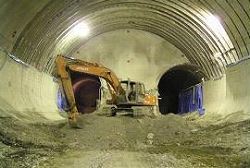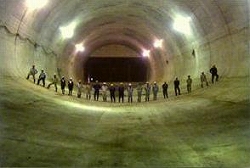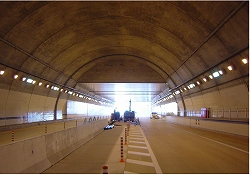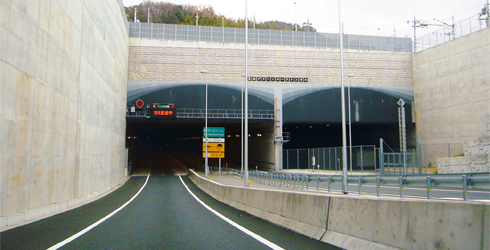Our BusinessMino Tunnel Construction Project [Osaka Prefecture]
The Challenge of a Tunnel More Than 5 km Long - One of Japan’s Biggest Super-Large-Section Tunnels
Northern Osaka Prefecture, along with neighboring southeastern Hyogo Prefecture, lies within commuting distance of the Osaka metropolitan area. Traffic passing from northern Osaka Prefecture to the metropolitan area concentrates along National Route 423 where it becomes highly congested on a daily basis. The Mino Toll Road was planned with the aim of alleviating this traffic congestion while providing access to the Mizu to Midori no Kenko Toshi (literally "Water and Green Health City") currently under development in Mino Shinmachi. This is a 7.2-km road exclusively for use by automobiles which starts at the Kayano Intersection of National Route 171. In the long-term, there were even plans to connect the road to the Shin-Meishin Expressway.
The Mino Tunnel construction project was a project to construct a tunnel more than 5 km long, covering the section of the Mino Toll Road from Hakushima, Mino to Shimo-Todoromi. Osaka Prefectural Road Public Corporation has played a central role in driving the project. Mountain tunnel construction work began in 1998 and entered service without incident in 2007.
As the project involved the construction of a large tunnel more than 5 km in length, an undertaking with few precedents to date, and would have a ramp merging point inside the tunnel at the Hakushima, Mino South Tunnel Entrance, the challenge faced was the creation of a super-large-section tunnel through one of the biggest mountain tunnel construction methods in Japan. For this reason, Pacific Consultants’ technical capabilities were a big key towards ensuring the project’s success.
An Unprecedented Super-Large-Section Tunnel for Unconsolidated Sediment Ground
The Mino Tunnel construction project comprised a 5,523-meter-long main tunnel, 5,572-meter-long evacuation tunnel and a 331-meter-long ventilation shaft, along with one underground ventilation station, one management office, one electrical room, and facilities for lighting, ventilation and disaster risk reduction and management. Pacific Consultants took part in the overall planning, design and construction management for these elements, along with a series of project management tasks.
The geological features distributed along the tunnel route are broadly classified into two basement rocks in the tunnel center. The south side is a Tanba belt, a kind of sedimentary rock primarily composed of sandstone and shale referred to as a Mesozoic Tanba Group. On the other hand, it was believed that a Super-Tanba belt was distributed along the north side, primarily made up of sandstone. Of these formations, the south-side tunnel entrance included a distribution of unconsolidated Osaka Group soil, and came into contact with the north edge fault complex of the Arima-Takatsuki Tectonic Line. In addition, shale basement rock was also strongly affected by the Nyoidani Fault, and overall crumbling was notable.
According to the road plans, the Mino Toll Road was to be linked up with the main line of the Shin-Midosuji (a limited expressway) as a road exclusively for automobiles, and needed to be able to connect smoothly with National Route 171. For this reason, a canal structure unifying the main line and ramp near the south tunnel entrance was employed. As this format allowed movement straight into the tunnel, a roughly 250-meter section from the south tunnel entrance was planned as an enlarged part with a large sectional area. Given this, to reduce the danger when drivers that had driven from aboveground merged while underground, a longer merge length that took drivers’ adaptation to darkness into account was ensured.
In addition, according to the plans for the road width configuration including a ramp lane, when the two lanes of the main line (excavation cross-sectional area of 80 m2) were included with the ramp lane, total road width was greater than 15 meters. For this reason, if constructed using the mountain tunneling method, the cavity cross-sectional area would be over 200 m2 and excavation cross-sectional area would be more than 300 m2, making it a super-large-section tunnel.
Examples of previous large sectional areas of road tunnels constructed with the mountain tunneling method included the Shin-Kobe Tunnel and Nunobiki Tunnel (II), which were designed by Pacific Consultants. The junction sections of these tunnels had excavation cross-sectional areas of around 240 m2, but the rock mass was fresh granite. While there are other examples of large sectional areas (underground spaces) such as underground power generating plants, in each case they were constructed deep in the hard bedrock of a mountain. By comparison, the south entrance area where the Mino Tunnel ramp was situated was a distribution of Osaka Group unconsolidated ground (sediment ground) with alternating gravel and cohesive soil layers. Therefore, the construction of a super-large-section tunnel with an excavation cross-sectional area of more than 300 m2 in such weak ground was an unprecedented tunnel plan, even by Japanese standards.


Allowable Tolerance for the 23-meter Excavation Width Was Just Ten Centimeters
The specific issues faced when constructing an unprecedented super-large-section tunnel with an excavation cross-sectional area of over 300 m2 were threefold: (1) Can the working face of a large tunnel excavation with a super-large section structurally stand on its own? (2) Is it possible to construct a lining able to withstand the large load of loosened bedrock? (3) Can the ground support the aforementioned load?
Given this, the first step was to analyze the measurement results of the service tunnel that had been constructed in advance and the standard cross-sectional segment up to the super-large-section area. When the stability of the surrounding ground was assessed through reproduction analysis, it was found that to construct a large cross-sectional area of the ground using the mountain tunneling construction method to ensure a cavity cross-sectional area of more than 200 m2 and excavation cross-sectional area of more than 300 m2, it would be necessary to limit cavity displacement to around ten centimeters in order to ensure working face stability.
Accordingly, when constructing a mountain tunnel involving unconsolidated sediment ground such as this combined with the construction of a super-large-sectional area, dividing up the cross section of the tunnel face and excavating with sectional areas as small as possible was thought to be the basic approach. Generally speaking, this is regarded as the top heading and bench method of advance, but considering construction examples in Japan and overseas and the results of conducting a FEM analysis, the decision was made to employ the side heading construction method. In terms of supplementary construction methods, the filling-type long-size steel pipe tip receiving method (Trevi Tube Method) was considered, but due to its low reliability as a supplementary construction method for a super-large-sectional area, the pipe roofing method was selected due to its strong supporting effects.
In addition, after approaches such as the excavation method, supporting construction and supplementary construction method had been decided on, the structural design of the tunnel upon completion was considered. For the structure of the lining against the load of loosened bedrock, as a result of analysis involving the placement of full overburden weight, it was confirmed that although the member thickness of secondary lining concrete is thicker compared to the regular structure, this can be handled by adopting a reinforced concrete structure.
Moreover, as a result of examination based on FEM analysis of the ground bearing capacity, subsidence or co-falling of the upper leg portion and lower leg portion due to insufficient bearing capacity was a concern, but this was resolved by pre-placing side wall concrete to support the force acting upon the primary supports of the upper arch portion.
These were the major issues encountered when constructing a super-large-section tunnel in unconsolidated ground. However, since various considerations led to the conclusion that safe construction was possible, the decision was made to construct the super-large-section segment using the mountain tunneling method.
Developing a Groundwater Information Construction System – The SWING Method
The Mino Tunnel was a plan to cut longitudinally through Mino Quasi-National Park, which makes up a corner of the base of the Hokusetsu Mountains. For this reason, it was necessary to take environmental conservation into account. This included scenic spots such as the Mino Falls and Katsuo-ji Temple, Mino monkeys, which are regarded as natural treasures, and other precious flora and fauna such as the Japanese giant salamander.
To start with, studies were conducted on the usage of domestic water and agricultural water related to the Mino Falls and Minogawa Dam, and on the usage of rivers, mountain runoff, spring water and so forth. As a result, it was determined that environmental issues related to the hydrology of the surrounding area needed to be handled in connection with the project construction. In response, an effort was made to develop a prediction method to swiftly assess the impact on groundwater (lowering of groundwater levels, change in mountain runoff flow, tunnel spring water flow, etc.) from construction to after completion. As a result, Pacific Consultants developed the unique SWING (System on Water Information of Ground) system as an analysis method that does not use conventional dedicated software, and began to use the system.
Emotions During Completion of Construction and Service Launch, and Pride as an Engineer
The Mino Tunnel overcame many construction difficulties and was completed without incident in March 2006. From May 2007, it entered service as part of the Mino Green Road.
"As a tunnel engineer, being involved with a big project such as this one makes me feel lucky to be an engineer. And it was only possible because I’m at Pacific Consultants." (Toru Yasuda, General Manager, Tunnel Department, Transportation Engineering Division)
"In addition to using analysis techniques in the design of a city NATM tunnel with one of the largest super-large-sectional areas in Japan, through information-based construction that involved assessment through measurement data analysis and reconstruction analysis during construction, we managed to complete the construction of a super-large-section tunnel. Today this represents a touchstone in my career in tunnel engineering." (Tomoaki Kato, Leader, Mountain Tunnel Group, Tunnel Department)
"During construction, when I would look up at the ceiling portion of the tunnel from the side heading eleven meters below, I was awestruck by the sheer size of the cross section. But since everyone involved with the project including the project owner and construction contractors made a concerted effort to solve the issues we faced, I had confidence and was not worried." (Hironori Tajika, Tunnel Group, Osaka Head Office)
As the remarks from the three engineers above show, Pacific Consultants’ tunnel technologies have established one of the leading track records in Japan. Accordingly, we boast the largest market share of tunnel-related public works projects in Japan.
Due to the completion of the Mino Tunnel, the traffic congestion along National Route 423 generated from northern Osaka Prefecture was alleviated, and it became easier to access Kameoka City and "Water and Green Health City" (Mino Shinmachi). It is also expected that future plans to connect to the Shin-Meishin Expressway interchange will further contribute to economic and cultural development in the Kansai region. A single tunnel can create new value and breathe new life into a city. "Pacific Consultants’ works are eternal. They retain a physical form. My job is to create new value for society. I’m also proud of this in front of my family. I’ll say things like, ‘You know your dad made this tunnel.’ To be honest, they don’t seem that interested. It annoyed me a little," he says with a wry smile. —Perhaps these words more than anything reveal the significance of a job as a construction consultant.


Pacific Consultants boasts an extensive track record in Japan and overseas as a pioneer in comprehensive construction consulting. Our consultants are ready to respond extensively based on the latest information to any questions from order placement representatives.

